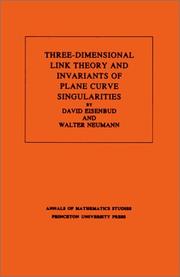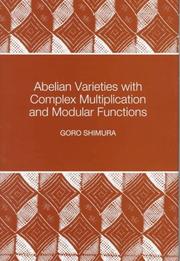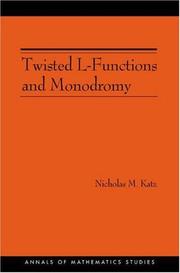| Listing 1 - 5 of 5 |
Sort by
|

ISBN: 0691083819 0691083800 1400881927 9780691083810 9780691083803 Year: 1985 Volume: 110 Publisher: Princeton (N.J.): Princeton university press,
Abstract | Keywords | Export | Availability | Bookmark
 Loading...
Loading...Choose an application
- Reference Manager
- EndNote
- RefWorks (Direct export to RefWorks)
This book gives a new foundation for the theory of links in 3-space modeled on the modern developmentby Jaco, Shalen, Johannson, Thurston et al. of the theory of 3-manifolds. The basic construction is a method of obtaining any link by "splicing" links of the simplest kinds, namely those whose exteriors are Seifert fibered or hyperbolic. This approach to link theory is particularly attractive since most invariants of links are additive under splicing.Specially distinguished from this viewpoint is the class of links, none of whose splice components is hyperbolic. It includes all links constructed by cabling and connected sums, in particular all links of singularities of complex plane curves. One of the main contributions of this monograph is the calculation of invariants of these classes of links, such as the Alexander polynomials, monodromy, and Seifert forms.
Algebraic geometry --- Differential geometry. Global analysis --- Link theory. --- Curves, Plane. --- SINGULARITIES (Mathematics) --- Curves, Plane --- Invariants --- Link theory --- Singularities (Mathematics) --- Geometry, Algebraic --- Low-dimensional topology --- Piecewise linear topology --- Higher plane curves --- Plane curves --- Invariants. --- 3-sphere. --- Alexander Grothendieck. --- Alexander polynomial. --- Algebraic curve. --- Algebraic equation. --- Algebraic geometry. --- Algebraic surface. --- Algorithm. --- Ambient space. --- Analytic function. --- Approximation. --- Big O notation. --- Call graph. --- Cartesian coordinate system. --- Characteristic polynomial. --- Closed-form expression. --- Cohomology. --- Computation. --- Conjecture. --- Connected sum. --- Contradiction. --- Coprime integers. --- Corollary. --- Curve. --- Cyclic group. --- Determinant. --- Diagram (category theory). --- Diffeomorphism. --- Dimension. --- Disjoint union. --- Eigenvalues and eigenvectors. --- Equation. --- Equivalence class. --- Euler number. --- Existential quantification. --- Exterior (topology). --- Fiber bundle. --- Fibration. --- Foliation. --- Fundamental group. --- Geometry. --- Graph (discrete mathematics). --- Ground field. --- Homeomorphism. --- Homology sphere. --- Identity matrix. --- Integer matrix. --- Intersection form (4-manifold). --- Isolated point. --- Isolated singularity. --- Jordan normal form. --- Knot theory. --- Mathematical induction. --- Monodromy matrix. --- Monodromy. --- N-sphere. --- Natural transformation. --- Newton polygon. --- Newton's method. --- Normal (geometry). --- Notation. --- Pairwise. --- Parametrization. --- Plane curve. --- Polynomial. --- Power series. --- Projective plane. --- Puiseux series. --- Quantity. --- Rational function. --- Resolution of singularities. --- Riemann sphere. --- Riemann surface. --- Root of unity. --- Scientific notation. --- Seifert surface. --- Set (mathematics). --- Sign (mathematics). --- Solid torus. --- Special case. --- Stereographic projection. --- Submanifold. --- Summation. --- Theorem. --- Three-dimensional space (mathematics). --- Topology. --- Torus knot. --- Torus. --- Tubular neighborhood. --- Unit circle. --- Unit vector. --- Unknot. --- Variable (mathematics).

ISBN: 0691016569 1400883946 9780691016566 Year: 1998 Volume: 46 Publisher: Princeton (N.J.): Princeton university press,
Abstract | Keywords | Export | Availability | Bookmark
 Loading...
Loading...Choose an application
- Reference Manager
- EndNote
- RefWorks (Direct export to RefWorks)
Reciprocity laws of various kinds play a central role in number theory. In the easiest case, one obtains a transparent formulation by means of roots of unity, which are special values of exponential functions. A similar theory can be developed for special values of elliptic or elliptic modular functions, and is called complex multiplication of such functions. In 1900 Hilbert proposed the generalization of these as the twelfth of his famous problems. In this book, Goro Shimura provides the most comprehensive generalizations of this type by stating several reciprocity laws in terms of abelian varieties, theta functions, and modular functions of several variables, including Siegel modular functions. This subject is closely connected with the zeta function of an abelian variety, which is also covered as a main theme in the book. The third topic explored by Shimura is the various algebraic relations among the periods of abelian integrals. The investigation of such algebraicity is relatively new, but has attracted the interest of increasingly many researchers. Many of the topics discussed in this book have not been covered before. In particular, this is the first book in which the topics of various algebraic relations among the periods of abelian integrals, as well as the special values of theta and Siegel modular functions, are treated extensively.
Ordered algebraic structures --- 512.74 --- Abelian varieties --- Modular functions --- Functions, Modular --- Elliptic functions --- Group theory --- Number theory --- Varieties, Abelian --- Geometry, Algebraic --- Algebraic groups. Abelian varieties --- 512.74 Algebraic groups. Abelian varieties --- Abelian varieties. --- Modular functions. --- Abelian extension. --- Abelian group. --- Abelian variety. --- Absolute value. --- Adele ring. --- Affine space. --- Affine variety. --- Algebraic closure. --- Algebraic equation. --- Algebraic extension. --- Algebraic number field. --- Algebraic structure. --- Algebraic variety. --- Analytic manifold. --- Automorphic function. --- Automorphism. --- Big O notation. --- CM-field. --- Characteristic polynomial. --- Class field theory. --- Coefficient. --- Complete variety. --- Complex conjugate. --- Complex multiplication. --- Complex number. --- Complex torus. --- Corollary. --- Degenerate bilinear form. --- Differential form. --- Direct product. --- Direct proof. --- Discrete valuation ring. --- Divisor. --- Eigenvalues and eigenvectors. --- Embedding. --- Endomorphism. --- Existential quantification. --- Field of fractions. --- Finite field. --- Fractional ideal. --- Function (mathematics). --- Fundamental theorem. --- Galois extension. --- Galois group. --- Galois theory. --- Generic point. --- Ground field. --- Group theory. --- Groupoid. --- Hecke character. --- Homology (mathematics). --- Homomorphism. --- Identity element. --- Integer. --- Irreducibility (mathematics). --- Irreducible representation. --- Lie group. --- Linear combination. --- Linear subspace. --- Local ring. --- Modular form. --- Natural number. --- Number theory. --- Polynomial. --- Prime factor. --- Prime ideal. --- Projective space. --- Projective variety. --- Rational function. --- Rational mapping. --- Rational number. --- Real number. --- Residue field. --- Riemann hypothesis. --- Root of unity. --- Scientific notation. --- Semisimple algebra. --- Simple algebra. --- Singular value. --- Special case. --- Subgroup. --- Subring. --- Subset. --- Summation. --- Theorem. --- Vector space. --- Zero element.

ISBN: 1282820893 9786612820892 1400824885 069109151X 0691091501 9781400824885 9780691091501 9780691091518 9781282820890 6612820896 Year: 2002 Volume: 150 Publisher: Princeton Princeton University Press
Abstract | Keywords | Export | Availability | Bookmark
 Loading...
Loading...Choose an application
- Reference Manager
- EndNote
- RefWorks (Direct export to RefWorks)
For hundreds of years, the study of elliptic curves has played a central role in mathematics. The past century in particular has seen huge progress in this study, from Mordell's theorem in 1922 to the work of Wiles and Taylor-Wiles in 1994. Nonetheless, there remain many fundamental questions where we do not even know what sort of answers to expect. This book explores two of them: What is the average rank of elliptic curves, and how does the rank vary in various kinds of families of elliptic curves? Nicholas Katz answers these questions for families of ''big'' twists of elliptic curves in the function field case (with a growing constant field). The monodromy-theoretic methods he develops turn out to apply, still in the function field case, equally well to families of big twists of objects of all sorts, not just to elliptic curves. The leisurely, lucid introduction gives the reader a clear picture of what is known and what is unknown at present, and situates the problems solved in this book within the broader context of the overall study of elliptic curves. The book's technical core makes use of, and explains, various advanced topics ranging from recent results in finite group theory to the machinery of l-adic cohomology and monodromy. Twisted L-Functions and Monodromy is essential reading for anyone interested in number theory and algebraic geometry.
L-functions. --- Monodromy groups. --- Functions, L --- -L-functions. --- Group theory --- -Number theory --- L-functions --- Monodromy groups --- Abelian variety. --- Absolute continuity. --- Addition. --- Affine space. --- Algebraically closed field. --- Ambient space. --- Average. --- Betti number. --- Birch and Swinnerton-Dyer conjecture. --- Blowing up. --- Codimension. --- Coefficient. --- Computation. --- Conjecture. --- Conjugacy class. --- Convolution. --- Critical value. --- Differential geometry of surfaces. --- Dimension (vector space). --- Dimension. --- Direct sum. --- Divisor (algebraic geometry). --- Divisor. --- Eigenvalues and eigenvectors. --- Elliptic curve. --- Equation. --- Equidistribution theorem. --- Existential quantification. --- Factorization. --- Finite field. --- Finite group. --- Finite set. --- Flat map. --- Fourier transform. --- Function field. --- Functional equation. --- Goursat's lemma. --- Ground field. --- Group representation. --- Hyperplane. --- Hypersurface. --- Integer matrix. --- Integer. --- Irreducible component. --- Irreducible polynomial. --- Irreducible representation. --- J-invariant. --- K3 surface. --- L-function. --- Lebesgue measure. --- Lefschetz pencil. --- Level of measurement. --- Lie algebra. --- Limit superior and limit inferior. --- Minimal polynomial (field theory). --- Modular form. --- Monodromy. --- Morphism. --- Numerical analysis. --- Orthogonal group. --- Percentage. --- Polynomial. --- Prime number. --- Probability measure. --- Quadratic function. --- Quantity. --- Quotient space (topology). --- Representation theory. --- Residue field. --- Riemann hypothesis. --- Root of unity. --- Scalar (physics). --- Set (mathematics). --- Sheaf (mathematics). --- Subgroup. --- Summation. --- Symmetric group. --- System of imprimitivity. --- Theorem. --- Trivial representation. --- Zariski topology.
Book
ISBN: 0691643024 1400853656 9781400853656 9781306988988 1306988985 0691082510 9780691615622 Year: 1981 Publisher: Princeton, N.J. Princeton University Press
Abstract | Keywords | Export | Availability | Bookmark
 Loading...
Loading...Choose an application
- Reference Manager
- EndNote
- RefWorks (Direct export to RefWorks)
The purpose of this book is to provide a self-contained account, accessible to the non-specialist, of algebra necessary for the solution of the integrability problem for transitive pseudogroup structures.Originally published in 1981.The Princeton Legacy Library uses the latest print-on-demand technology to again make available previously out-of-print books from the distinguished backlist of Princeton University Press. These editions preserve the original texts of these important books while presenting them in durable paperback and hardcover editions. The goal of the Princeton Legacy Library is to vastly increase access to the rich scholarly heritage found in the thousands of books published by Princeton University Press since its founding in 1905.
Lie algebras. --- Ideals (Algebra) --- Pseudogroups. --- Global analysis (Mathematics) --- Lie groups --- Algebraic ideals --- Algebraic fields --- Rings (Algebra) --- Algebras, Lie --- Algebra, Abstract --- Algebras, Linear --- Lie algebras --- Pseudogroups --- 512.81 --- 512.81 Lie groups --- Ideals (Algebra). --- Lie, Algèbres de. --- Idéaux (algèbre) --- Pseudogroupes (mathématiques) --- Ordered algebraic structures --- Analytical spaces --- Addition. --- Adjoint representation. --- Algebra homomorphism. --- Algebra over a field. --- Algebraic extension. --- Algebraic structure. --- Analytic function. --- Associative algebra. --- Automorphism. --- Bilinear form. --- Bilinear map. --- Cartesian product. --- Closed graph theorem. --- Codimension. --- Coefficient. --- Cohomology. --- Commutative ring. --- Commutator. --- Compact space. --- Complex conjugate. --- Complexification (Lie group). --- Complexification. --- Conjecture. --- Constant term. --- Continuous function. --- Contradiction. --- Corollary. --- Counterexample. --- Diagram (category theory). --- Differentiable manifold. --- Differential form. --- Differential operator. --- Dimension (vector space). --- Dimension. --- Direct sum. --- Discrete space. --- Donald C. Spencer. --- Dual basis. --- Embedding. --- Epimorphism. --- Existential quantification. --- Exterior (topology). --- Exterior algebra. --- Exterior derivative. --- Faithful representation. --- Formal power series. --- Graded Lie algebra. --- Ground field. --- Homeomorphism. --- Homomorphism. --- Hyperplane. --- I0. --- Indeterminate (variable). --- Infinitesimal transformation. --- Injective function. --- Integer. --- Integral domain. --- Invariant subspace. --- Invariant theory. --- Isotropy. --- Jacobi identity. --- Levi decomposition. --- Lie algebra. --- Linear algebra. --- Linear map. --- Linear subspace. --- Local diffeomorphism. --- Mathematical induction. --- Maximal ideal. --- Module (mathematics). --- Monomorphism. --- Morphism. --- Natural transformation. --- Non-abelian. --- Partial differential equation. --- Pseudogroup. --- Pullback (category theory). --- Simple Lie group. --- Space form. --- Special case. --- Subalgebra. --- Submanifold. --- Subring. --- Summation. --- Symmetric algebra. --- Symplectic vector space. --- Telescoping series. --- Theorem. --- Topological algebra. --- Topological space. --- Topological vector space. --- Topology. --- Transitive relation. --- Triviality (mathematics). --- Unit vector. --- Universal enveloping algebra. --- Vector bundle. --- Vector field. --- Vector space. --- Weak topology. --- Lie, Algèbres de. --- Idéaux (algèbre) --- Pseudogroupes (mathématiques)
Book
ISBN: 0691197938 Year: 2019 Publisher: Princeton, NJ : Princeton University Press,
Abstract | Keywords | Export | Availability | Bookmark
 Loading...
Loading...Choose an application
- Reference Manager
- EndNote
- RefWorks (Direct export to RefWorks)
This book studies the interplay between the geometry and topology of locally symmetric spaces, and the arithmetic aspects of the special values of L-functions.The authors study the cohomology of locally symmetric spaces for GL(N) where the cohomology groups are with coefficients in a local system attached to a finite-dimensional algebraic representation of GL(N). The image of the global cohomology in the cohomology of the Borel-Serre boundary is called Eisenstein cohomology, since at a transcendental level the cohomology classes may be described in terms of Eisenstein series and induced representations. However, because the groups are sheaf-theoretically defined, one can control their rationality and even integrality properties. A celebrated theorem by Langlands describes the constant term of an Eisenstein series in terms of automorphic L-functions. A cohomological interpretation of this theorem in terms of maps in Eisenstein cohomology allows the authors to study the rationality properties of the special values of Rankin-Selberg L-functions for GL(n) x GL(m), where n + m = N. The authors carry through the entire program with an eye toward generalizations.This book should be of interest to advanced graduate students and researchers interested in number theory, automorphic forms, representation theory, and the cohomology of arithmetic groups.
Shimura varieties. --- Cohomology operations. --- Number theory. --- Arithmetic groups. --- L-functions. --- Functions, L --- -Number theory --- Group theory --- Number study --- Numbers, Theory of --- Algebra --- Operations (Algebraic topology) --- Algebraic topology --- Varieties, Shimura --- Arithmetical algebraic geometry --- Addition. --- Adele ring. --- Algebraic group. --- Algebraic number theory. --- Arithmetic group. --- Automorphic form. --- Base change. --- Basis (linear algebra). --- Bearing (navigation). --- Borel subgroup. --- Calculation. --- Category of groups. --- Coefficient. --- Cohomology. --- Combination. --- Commutative ring. --- Compact group. --- Computation. --- Conjecture. --- Constant term. --- Corollary. --- Covering space. --- Critical value. --- Diagram (category theory). --- Dimension. --- Dirichlet character. --- Discrete series representation. --- Discrete spectrum. --- Eigenvalues and eigenvectors. --- Eisenstein series. --- Elaboration. --- Embedding. --- Euler product. --- Field extension. --- Field of fractions. --- Free module. --- Freydoon Shahidi. --- Function field. --- Functor. --- Galois group. --- Ground field. --- Group (mathematics). --- Group scheme. --- Harish-Chandra. --- Hecke L-function. --- Hecke character. --- Hecke operator. --- Hereditary property. --- Induced representation. --- Irreducible representation. --- K0. --- L-function. --- Langlands dual group. --- Level structure. --- Lie algebra cohomology. --- Lie algebra. --- Lie group. --- Linear combination. --- Linear map. --- Local system. --- Maximal torus. --- Modular form. --- Modular symbol. --- Module (mathematics). --- Monograph. --- N0. --- National Science Foundation. --- Natural number. --- Natural transformation. --- Nilradical. --- Permutation. --- Prime number. --- Quantity. --- Rational number. --- Reductive group. --- Requirement. --- Ring of integers. --- Root of unity. --- SL2(R). --- Scalar (physics). --- Sheaf (mathematics). --- Special case. --- Spectral sequence. --- Standard L-function. --- Subgroup. --- Subset. --- Summation. --- Tensor product. --- Theorem. --- Theory. --- Triangular matrix. --- Triviality (mathematics). --- Two-dimensional space. --- Unitary group. --- Vector space. --- W0. --- Weyl group.
| Listing 1 - 5 of 5 |
Sort by
|

 Search
Search Feedback
Feedback About UniCat
About UniCat  Help
Help News
News